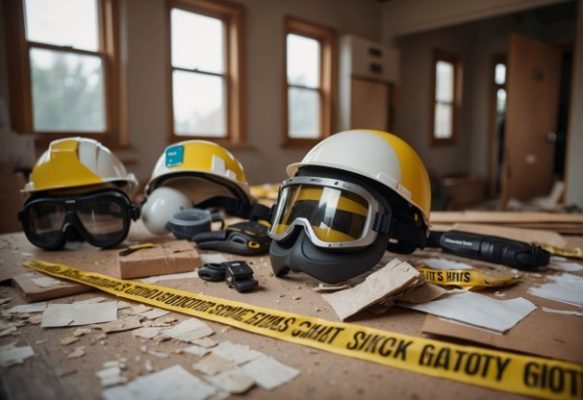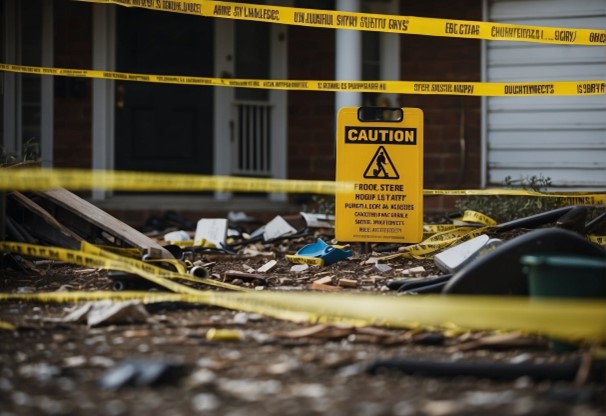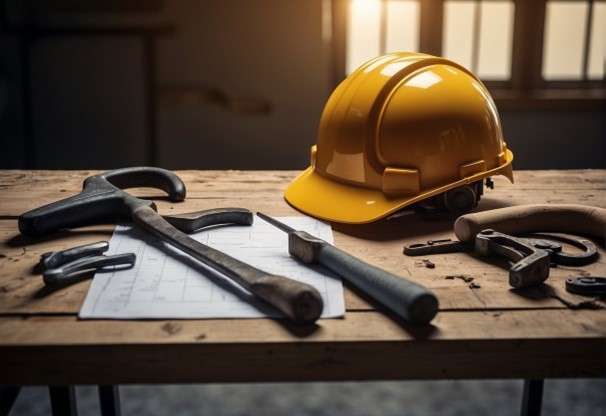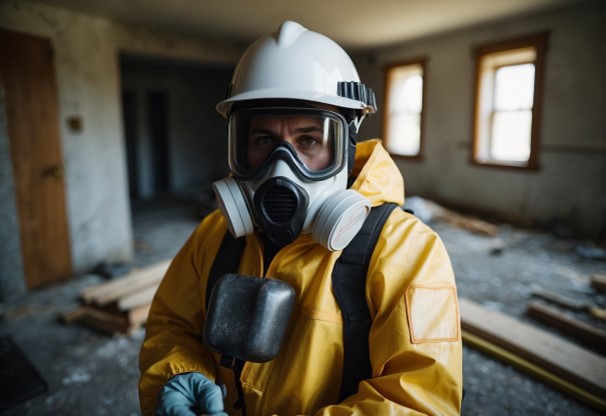
Demolishing a home is a significant undertaking. It requires careful planning and consideration of safety protocols to protect both the individuals involved and the surrounding environment.
Safety during demolition is paramount. The process involves a variety of risks, from structural collapses to exposure to hazardous materials.
Homeowners must take a proactive approach to ensure that all demolition activities are carried out safely and in accordance with local regulations and industry standards.
An essential first step for homeowners is to prepare the property for demolition.
This entails securing the necessary permits, conducting thorough inspections for hazardous materials, and developing a clear plan for the demolition process.
It is crucial that homeowners equip themselves and their workers with the appropriate safety gear.
They should also familiarize themselves with operational best practices to mitigate potential risks.
All it takes is a phone call

Before beginning the demolition process, homeowners should prioritize creating a comprehensive demolition plan, securing all necessary permits, and conducting a thorough site assessment.
These steps are crucial to ensure safety, compliance with local regulations, and efficiency throughout the demolition phase.
Demolition Plan
The demolition plan should be detailed and developed by professionals to outline the project’s scope and method.
It includes identifying the parts of the home to be demolished, the sequence of work, and the safety measures to be implemented.
The plan should also establish a clear timeline for the project’s completion and designate a project manager responsible for overseeing the entire operation.
Securing Necessary Permits
Demolition cannot proceed without securing the required permits from local authorities. These permits confirm that the project adheres to all local regulations, zoning laws, and safety standards.
Homeowners should consult with their project manager or contractor who will usually handle the permitting process.
They will ensure that all paperwork is filed correctly and that there are no legal obstacles to moving forward with the demolition.
Site Assessment and Pre-Construction Information
A comprehensive site assessment is essential to identify potential hazards and gather pre-construction information.
This should include checking for hazardous materials, documenting existing structural conditions, and understanding the surrounding environment to mitigate any risks to nearby structures or occupants.
This phase demands the input of specialists who can effectively assess the site conditions and develop strategies to minimize safety risks for both workers and the community.

When embarking on a home demolition project, homeowners must prioritize safety by employing the correct safety measures and using the appropriate equipment.
Personal Protective Equipment (PPE)
PPE is essential to protect against physical hazards during demolition.
Homeowners should wear a hard hat to shield against falling debris, safety glasses to prevent eye injuries, and heavy-duty gloves to protect hands from sharp objects and abrasions.
Safety boots with slip-resistant and puncture-proof soles are crucial for foot protection.
Moreover, it is imperative to use masks or respirators, especially when dealing with substances that may become airborne and potentially inhaled.
Selecting the Right Tools
Choosing the right tools is not only about efficiency but also about safety.
Tools must be appropriate for the tasks at hand, and older or damaged equipment should be replaced or repaired before use.
Utilize the correct safety equipment that can handle the expected load and has the necessary safety features to prevent accidents.
Consult with experts if uncertain about the suitability of a tool for a particular demolition phase.
Health and Safety Plan
A health and safety plan is a comprehensive approach that outlines the procedures and safety measures to be followed.
This includes identifying potential hazards, establishing evacuation routes, and ensuring proper communication among the entire demolition team.
The plan should encompass the use of personal protective equipment and detail how to safely operate equipment.
Regular training and safety briefings can enhance the execution of the plan, keeping all participants well-informed and prepared.
All it takes is a phone call

When starting a home demolition project, homeowners must prioritize the safe handling of hazardous materials.
It’s imperative to identify and manage these substances properly to ensure the health and safety of all involved, as well as compliance with environmental standards.
Asbestos and Lead
Asbestos and lead, often hidden in older homes, pose significant health risks if disturbed or improperly handled during demolition.
Before any demolition activities begin, a professional survey to detect the presence of these materials is crucial.
If asbestos or lead is found, specialist contractors who follow strict safety protocols must be employed for removal.
Failing to manage these substances properly could lead to serious long-term health issues, such as asbestosis or lead poisoning. Thus, utilizing qualified personnel ensures these hazardous materials are handled without risking public health or the environment.
Waste Management and Disposal
Once hazardous materials have been safely removed, the next step is their proper waste management and disposal.
All waste must be categorized to distinguish between non-hazardous and hazardous materials.
Non-hazardous materials may have the potential for recycling or reuse, reducing the environmental impact of the demolition.
For hazardous waste, adhere to the prescribed safety standards for transport and disposal. This ensures the materials do not pose further risks.
Engage with licensed waste disposal facilities equipped to handle hazardous materials securely.
Documentation and tracking of hazardous waste are legally required and critical for transparency and accountability in the waste disposal process.
Correctly categorizing and managing demolition waste not only safeguards health but also supports environmental conservation efforts.
The key to successful home demolition lies in stringent operational practices. These include selecting the best demolition contractors, maintaining site safety, and considering both environmental impact and community well-being.
Engaging Qualified Demolition Contractors
Selecting a qualified demolition contractor is the first step toward an efficient and safe demolition process.
Homeowners should verify that the contractors they hire are experienced, trained, and certified.
A reputable contractor will conduct thorough site inspections and develop a comprehensive health and safety plan, addressing potential risks like injury from falling materials and uncontrolled collapse.
Checklist for Hiring Demolition Contractors:
Ensuring Site Safety
Site safety is paramount to protect workers and prevent accidents.
The demolition site should be well-organized to avoid hazards, and site safety measures must be implemented rigorously.
This includes securing areas at risk of injury from falling materials and ensuring that an uncontrolled collapse is prevented through proper structural assessment and demolition techniques.
Key Safety Measures:
Environmental and Community Considerations
A responsible demolition contractor will prioritize environmental protection and engage with the local community to mitigate the impact of demolition activities.
It involves dust control, noise reduction, and proper disposal of demolition waste to prevent environmental contamination.
Environmental and Community Best Practices:
Home demolition is a complex task that involves understanding the inherent risks and ensuring adherence to legal standards.
Proper management can significantly diminish the chances of accidents and non-compliance penalties.
Recognizing and Mitigating Risks
When considering home demolition, homeowners must identify and mitigate potential risks to ensure a safe demolition process.
These risks often include:
To mitigate these risks, homeowners should consult with professionals who can provide expert guidance and execution.
Legal and Insurance Considerations
Compliance with local, state, and federal regulations is essential in home demolition to avoid legal repercussions, such as fines.
Homeowners must obtain the necessary permits and adhere to zoning regulations. They also need a thorough understanding of traffic management and environmental controls.
The following table outlines the key compliance areas:
| Compliance Area | Importance |
| Permits | Ensures the demolition is legally sanctioned and regulations are met |
| Environmental | Protects local ecosystems from demolition-related hazards |
| Safety Standards | Reduces the risk of accidents and injuries |
Furthermore, verifying that the demolition contractor has valid insurance is critical to protect against liability for any incidents.
This insurance should cover a range of potential issues, from property damage to worker injury.
Homeowners themselves must consider their insurance coverage to safeguard against any risks stemming from the demolition activity, particularly if the property is adjacent to other structures or public areas.
When it’s time to start anew, demolition is the first critical step. J. Brownie Contracting doesn’t just demolish structures; we clear the way for your new visions.
With expertise honed since 1922, we ensure every project is handled with precision and care.
Don’t let outdated structures limit your potential. Make the bold choice—tear down the barriers and make room for innovation.
Contact us today, and take the first step towards constructing your future.
All it takes is a phone call
What are the essential safety precautions to observe before starting a house demolition?
Safety precautions include conducting a thorough inspection of the area to identify potential hazards and ensuring all utilities are disconnected.
How to identify and mitigate the safety hazards associated with home demolition?
To identify and mitigate safety hazards, one should assess the structural integrity of the building, determine the presence of hazardous materials, and plan for debris containment and fall prevention.
What protective gear is recommended for homeowners during a house demolition process?
Homeowners should wear hard hats, safety glasses, heavy-duty gloves, and steel-toed boots as the minimum protective gear to guard against injuries from debris and falls.
What are the crucial steps for thorough planning before a demolition project?
Key planning steps include obtaining necessary permits, creating a detailed demolition plan, and notifying neighbors about the demolition.
Planning details are available, including a list of the necessary safety equipment and precautions, on resources like OSHA Safety Manuals for demolition.
How should hazardous materials be handled during the demolition of a home?
Hazardous materials must be identified by a certified professional and removed according to local and federal regulations prior to demolition. This ensures the safety of workers and the environment.
What are the best practices for ensuring the structural safety of surrounding areas during demolition?
Best practices include using adequate fencing, controlling the fall of debris, and monitoring vibration levels to prevent damage to adjacent structures.